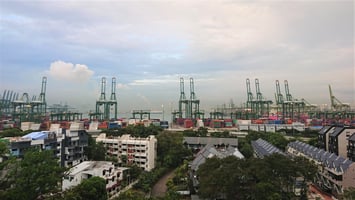Singapore is safe and secure, and one of the most politically stable countries in the world — and...
Covid-19 in Singapore: My View from the Ground
For many of us in manufacturing the biggest question from the COVID-19 pandemic is not about if or when we will come out of this situation but what are the lessons and how different the world will look in 6 months. On this platform we have been promoting Singapore as a business haven and through this crisis we continue to show why you can rely on Kusu to protect your supply chain. Today we are sharing the testimony of Winnie, our content marketing expert, about Covid-19 in Singapore. We realize that Singapore is unique in many ways and we are not trying to make it an example to follow. Our aim is to give all engineers, purchasing executives and company decision makers confidence in Singapore’s readiness to take up a greater leadership role in Southeast Asia.
By Winnie Mina, Content Marketing Expert living in Singapore with her family.
As someone who lives in Singapore with two young children, the news of the outbreak in Wuhan, China was worrying, to say the least.
Anyone who has been to Singapore knows just how much international traffic — especially from mainland China — Singapore gets. We knew that Singapore would start seeing cases soon.
But Covid-19 was not Singapore’s first brush with an epidemic. In 2003, Singapore battled SARS, which infected 238 people and killed 33. Singapore was unprepared then, but we did what we could.
The lessons learned from the SARS outbreak and developments in the local biotechnology industry have allowed us to launch a more measured response this time around.
The Government’s Approach
What stands out in the government's response is the balance between thoroughly tackling the spread of the virus while keeping the economy going.
The government is taking a middle path, choosing not to take drastic measures that may induce panic in the market.
Instead, its approach involves travel restrictions, thorough detection, and meticulous contact tracing, alongside transparent communication to the public.
This approach is not without its critics, but it appears to be working well so far. Even though the number of infections is climbing, the bulk of the cases are Singaporean residents returning from affected areas like Europe and North America.
Travel Restrictions and Controls
A few days after the first confirmed case of Covid-19 in Singapore, the government started to impose travel restrictions on visitors from Hubei, the epicenter of the epidemic.
This was subsequently widened to all foreign visitors with recent travel history to affected countries, as cases spiked in those places.
Initially, only travelers with recent travel history to affected locations were issued 14-day Stay-Home Notice (SHN). But the recent influx of imported cases has prompted the authorities to extend it to include all travelers entering Singapore.
An SHN is one step down from a Quarantine Order: Individuals have to stay at their place of residence for the entire duration, give location updates with GPS on their phone, and take photos of their surroundings if requested by the authorities. Breaching the SHN is a chargeable offense.
A recent spike in neighboring Malaysia linked to a large-scale religious event attended by 95 Singaporeans also prompted the government to take the unprecedented step of closing all mosques in Singapore for 14 days.
Aggressive Testing
In Singapore, tests are available for anyone with symptoms of Covid-19, even if those with no recent travel history. By testing thoroughly, Singapore is leaving no stone unturned, so we have as much visibility as possible and are not caught by surprise.
Singapore has conducted over 21,000 Covid-19 tests since the start of the outbreak in January. This is an average of 600–700 cases a day, far below Singapore’s capacity of up to 2,000 tests a day.
A locally developed serological test has also been used to detect individuals who have recovered. Authorities then use this information to establish links that were previously unknown.
To ensure that as many people as possible come forward for testing, the government is paying in full the medical bills associated with Covid-19 testing and hospitalization. It also pays employers $100 daily for workers affected by SHNs.
Contact Tracing and Quarantine
Contact tracers work around the clock, meticulously tracking an individual’s every movement in the days leading to diagnosis.
They rely on surveillance footage, ATM records, receipts, and even rope in the police to figure out how seemingly unlinked cases were acquired.
Legally binding Quarantine Orders are then served to people who have come into close contact with individuals who have tested positive for the virus.
The government takes contract tracing seriously.
Last month, a Chinese couple was charged with providing false information when questioned by contact tracing authorities. If convicted, they face penalties of up to six months’ jail, a maximum of S$10,000 fine, or both.
Communication and Education
It’s clear from the government’s communications that staving off panic is a priority. To this end, transparency in communication and education is an overarching theme in the government’s response.
The public is constantly being educated on the disease. Information about Covid-19 is all over public spaces — on TV, in the lifts, at the bus stop, and more.
Official updates from the health ministry are available both on traditional and social media. Daily updates include detailed information on each new confirmed case, the nature of their social contacts, and the locations they visited.
The Prime Minister has addressed the nation twice regarding the pandemic.
In each address, he communicated in concrete terms what Singapore could expect in terms of the medical, economic and psychological aspects of the pandemic. He also rallied the people to cooperate and reassured the public that the situation is under control.
***
For now, at least, the government’s approach seems to be effective.
Singapore is only slightly quieter than usual. Other than a short-lived bout of panic-buying, there has been no panic about the pandemic.
We wash our hands more, work from home where possible, and avoid large gatherings. Other than that, it’s pretty much business-as-usual for those of us who are not directly involved in the fight against the virus.
-1.jpg?width=146&height=50&name=Kusu%20(1)-1.jpg)



